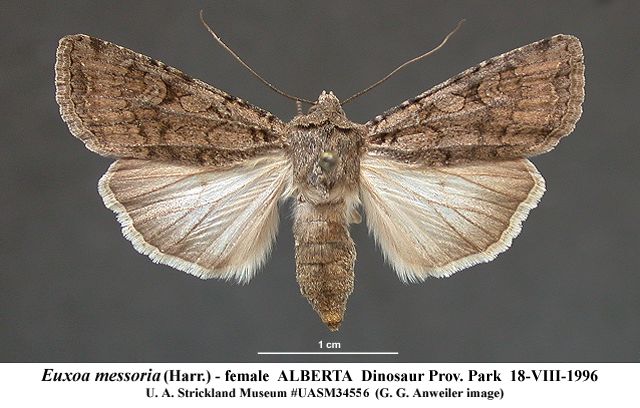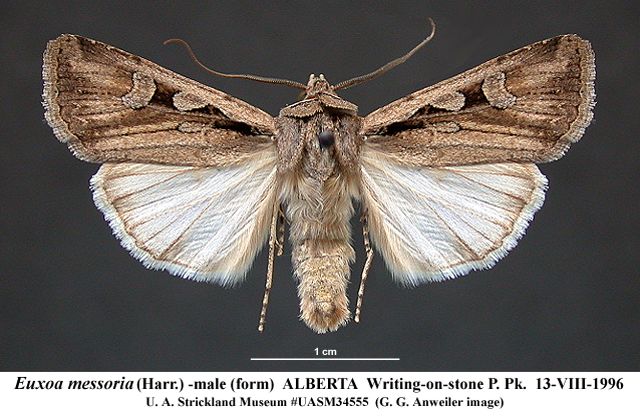Species Details
Euxoa messoria
University of Alberta E.H. Strickland Entomological Museum Read more about this collection »
Common NameReaper Dart, Dark-sided Cutworm
SeasonalityAdults have been collected in Alberta mid July-late September, with the peak in late August.
IdentificationA medium-size (3.2-3.6 cm wingspan) brownish-grey moth. Male antennae are strongly biserrate and bifasculate; female simple. Head and thorax even grey-brown without contrasting prothoracic collar. The basal, antemedian and postmedian lines on the forewings usually well marked and doubled, the later narrowly toothed at the veins. The orbicular and reniform spots are well defined, with the orbicular a large oval. A median line or shade is often present. The terminal area is narrowly darker than the remainder of the wing. Fringe concolorous with wing. Hindwing white in male, shading to light smoky-brown on the margin, more extensively dark shaded in females. There is a small discal dot, the veins are narrowly lined with brown scales, and the fringe is mostly white.
Form "atrifera" lacks the cross-lines on the forewings and has a broad black basal dash and a black streak before and between the orbicular and reniform, and the costa is often contrasting paler than the remainder of the wing.
Messoria belongs to the subgenus Longivesica, characterized by the extremely long vesica in the male and by the very long appendix bursae, twice the length of the corpus bursae, in females. Lafontaine (1987) provides keys to the subgenera and species of Euxoa>, and illustrates the genitalia of both sexes.
Scientific Name
Euxoa messoria
Common Name
Reaper Dart, Dark-sided Cutworm
Habitat
Open areas such as grasslands, cultivated areas and clearings.
Seasonality
Adults have been collected in Alberta mid July-late September, with the peak in late August.
Identification
A medium-size (3.2-3.6 cm wingspan) brownish-grey moth. Male antennae are strongly biserrate and bifasculate; female simple. Head and thorax even grey-brown without contrasting prothoracic collar. The basal, antemedian…
A medium-size (3.2-3.6 cm wingspan) brownish-grey moth. Male antennae are strongly biserrate and bifasculate; female simple. Head and thorax even grey-brown without contrasting prothoracic collar. The basal, antemedian and postmedian lines on the forewings usually well marked and doubled, the later narrowly toothed at the veins. The orbicular and reniform spots are well defined, with the orbicular a large oval. A median line or shade is often present. The terminal area is narrowly darker than the remainder of the wing. Fringe concolorous with wing. Hindwing white in male, shading to light smoky-brown on the margin, more extensively dark shaded in females. There is a small discal dot, the veins are narrowly lined with brown scales, and the fringe is mostly white.
Form "atrifera" lacks the cross-lines on the forewings and has a broad black basal dash and a black streak before and between the orbicular and reniform, and the costa is often contrasting paler than the remainder of the wing.
Messoria belongs to the subgenus Longivesica, characterized by the extremely long vesica in the male and by the very long appendix bursae, twice the length of the corpus bursae, in females. Lafontaine (1987) provides keys to the subgenera and species of Euxoa>, and illustrates the genitalia of both sexes.
Life History
There is a single brood each year, with the eggs over wintering. The larvae are climbing cutworms, sometimes damaging small trees and becoming pests on various crops. The larvae are active in spring and early summer.…
There is a single brood each year, with the eggs over wintering. The larvae are climbing cutworms, sometimes damaging small trees and becoming pests on various crops. The larvae are active in spring and early summer. The prepupal period is reported to be variable in length (Crumb, 1956). Adults and larvae are both nocturnal, and adults are attracted to both sugar baits and light.
Conservation
A common, widespread species occasionally reaching pest status; no concerns.
Diet Info
A wide variety of plants in many families, including tobacco, corn and a wide variety of vegetables. The larvae prefer broad-leaved plants, but also consume grasses and corn seedlings.
Range
Newfoundland west to Yukon, south to Virginia and Missouri in the east and New Mexico, Arizona and California in the west. In Alberta messoria has been collected throughout the southern half of the province.
References
Author
Lafontaine, J. Donald
Title
Noctuoidea : Noctuidae (part)
Publication Date
1987
Pages
237
Author
Crumb, S. E.
Title
The Larvae of the Phalaenidae.
Publication Date
1956
Series Title
United States Department of Agriculture, Technical Bulletin
Volume
1135
Pages
1-356
Specimen Information
There are 93 specimens of this Species.
UASM114413 - Euxoa messoria
University of Alberta E.H. Strickland Entomological Museum
Place CollectedCanada: Alberta, Dinosaur Provincial Park
Collected ByTroubridge, J.; Anweiler, G.
Date Collected2001-08-14/2001-08-15
UASM114414 - Euxoa messoria
University of Alberta E.H. Strickland Entomological Museum
Place CollectedCanada: Alberta, Dinosaur Provincial Park
Collected ByTroubridge, J.; Anweiler, G.
Date Collected2001-08-14/2001-08-15
UASM114415 - Euxoa messoria
University of Alberta E.H. Strickland Entomological Museum
Place CollectedCanada: Alberta, Dinosaur Provincial Park
Collected ByTroubridge, J.; Anweiler, G.
Date Collected2001-08-14/2001-08-15
UASM114416 - Euxoa messoria
University of Alberta E.H. Strickland Entomological Museum
Place CollectedCanada: Alberta, Writing-On-Stone Provincial Park
Collected ByTroubridge, J.; Anweiler, G.
Date Collected1999-09-09
UASM114417 - Euxoa messoria
University of Alberta E.H. Strickland Entomological Museum
Place CollectedCanada: Saskatchewan, Burstall
Collected ByTroubridge, J.; Anweiler, G.
Date Collected2001-08-13
UASM114418 - Euxoa messoria
University of Alberta E.H. Strickland Entomological Museum
Place CollectedCanada: Saskatchewan, Burstall
Collected ByTroubridge, J.; Anweiler, G.
Date Collected2001-08-13
UASM114419 - Euxoa messoria
University of Alberta E.H. Strickland Entomological Museum
Place CollectedCanada: Saskatchewan, Burstall
Collected ByTroubridge, J.; Anweiler, G.
Date Collected2001-08-13
UASM114420 - Euxoa messoria
University of Alberta E.H. Strickland Entomological Museum
Place CollectedCanada: Saskatchewan, Burstall
Collected ByTroubridge, J.; Anweiler, G.
Date Collected2001-08-13
UASM114421 - Euxoa messoria
University of Alberta E.H. Strickland Entomological Museum
Place CollectedCanada: Alberta, Writing-On-Stone Provincial Park
Collected ByAnweiler, G.
Date Collected1996-08-14



